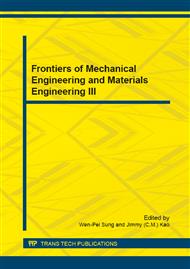[1]
Diaby M, Sablier M, Le Negrate A, et al. Understanding carbonaceous deposit formation resulting from engine oil degradation [J]. Carbon, 2009, 47(2): 355-366.
DOI: 10.1016/j.carbon.2008.10.014
Google Scholar
[2]
C.A.V. Daviss, Metal Cleaning Process, Feb. 6, 1940, Patent No. 2188930.
Google Scholar
[3]
R.E. Litchfield, G.W. Critchlow and S. Wilson, Surface cleaning technologies for the removal of crosslinked epoxide resin, International Journal of Adhesion & Adhesives, vol. 26, pp.295-303, Aug. (2006).
DOI: 10.1016/j.ijadhadh.2005.05.001
Google Scholar
[4]
F. Forsberg, Cleaning Oxides from Steel, Jun. 19, 1945, Patent No. 2378761.
Google Scholar
[5]
H.G. Webster, Composition and a process for electrolytic cleaning of metals, Apr. 19, 1956, Patent No. 2760927.
Google Scholar
[6]
H.G. Webster, Electrolytic ferrous metal cleaning, Jul. 30, 1957, Patent No. 2801215.
Google Scholar
[7]
W.E. White, Method for Cleaning Aluminum, Nov. 25, 1947, Patent No. 2431595.
Google Scholar
[8]
R.H. Shoemaker and W.G., Wood, Production Cleaning Systems Involving Molten Salt Baths, Metals Engineering Quarterly, vol. 11, pp.38-41, May (1971).
Google Scholar
[9]
R.H. Shoemaker, Molten salt process, Wire Journal, vol. 4, pp.33-38, Mar. (1971).
Google Scholar
[10]
J. Malloy. 2009. ExtremeCleaning, Available from http: /www. pfonline. com/articles/060901. html.
Google Scholar
[11]
R.H. Shoemaker, Molten salt baths reduce finishing time and cost, Metals Engineering Quarterly, vol. 13, pp.22-25, Feb. (1973).
Google Scholar
[12]
R. Dunlevy, H. Frick and J.H. Shoemaker, Apparatus and method for processing of steel strip continuously, Apr. 14, 1953, Patent No. 2635062.
Google Scholar
[13]
Long Y, Li J, Timmer D H, et al. Modeling and optimization of the molten salt cleaning process [J]. Journal of Cleaner Production, 2014, 68(0): 243-251.
DOI: 10.1016/j.jclepro.2013.12.075
Google Scholar
[14]
Diaby M, Singhal P, Ousmane M, et al. Impact factors for the degradation of engine oil causing carbonaceous deposits in the piston's grooves of Diesel engines[J]. Fuel, 2013, 107(0): 90-101.
DOI: 10.1016/j.fuel.2012.12.021
Google Scholar
[15]
Bradshaw R W, Meeker D E. High-temperature stability of ternary nitrate molten salts for solar thermal energy systems [J]. Solar Energy Materials, 1990, 21(1): 51-60.
DOI: 10.1016/0165-1633(90)90042-y
Google Scholar


